José Benet Espuny
Biography
José Benet Espuny was born on August 1st 1920 at the number 1 on "Ros de Medrano" street in Tortosa, province of Tarragona (Spain). He is the second son of Felipe Benet Estupiñá and Rosa Espuny Durán.
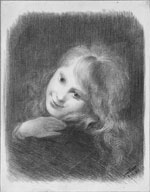
Drawn in the Cerveto
brothers' class.When he was young he used to fill his notebooks with drawings. The beginning of his career in art was on a rainy Thursday afternoon. He was 6 or 7 years of age. As he could not go out to play, he started to draw Cinteta, a neighbor who was helping his mother to mend socks. He remembers drawing her profile –he says to be easier-. His parents, upon realizing the resemblance the drawing had to the model, decided to send him to drawing lessons with the Cerveto brothers, Ricardo and Antonio. A few years later, he would also attend classes with his cousin and painter, Fernando Arasa. It was with him with whom he did his first oil painting at the age of 15.

His first oil painting,
done with Fernando ArasaDuring the Spanish Civil War, on 1938 and being only 17, he was called to arms. He was part of what was known as the "Nursing Bottle's Draft". He joined the fifth army corps of Lister, 46th division of "El Campesino", mobile attack brigade number 101. Benet Espuny thinks if he survived the war it was thanks to his ability to draw. At the beginning he drew plans in the observation and information detachment. Later he was assigned to the cartographical detachment of his brigade's staff. However, what he remembers most was the officials asking him to enlarge the photographs of their girlfriends or wives.
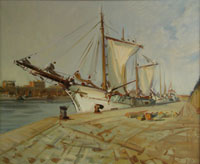
Barcelona HarbourIn 1942 he registered at the Superior School of Fine Arts of "Saint Jordi" in Barcelona, advised by Francisco Pérez Dolz, teacher at the institution. The school was located at Barcelona's old exchange building. He had as teachers among others Don Luis Monreal y Tejada, Art History; Miquel Ferré, Pictorial Methods; Armando Miravalls Bové, Painting and Color; Ernesto Santasusagna, Lluís Muntané and Rigoberto Solé, Drawing and Enric Monjo, Anatomy.
In 1945 he had his first individual exhibition in Tortosa. Don Luis Monreal y Tejada wrote the presentation for the catalog.
On that same year he transferred his registration to the Superior School of Fine Arts of "San Fernando" in Madrid recommended by several of his teachers who advised him to study Chalcographical Etching. It was a three years course, only imparted there. The director of the department was Francisco Esteve Botey.
In Madrid some of his teachers were: Manuel Benedito, Oil Painting; Enrique Lafuente Ferrari, Art History; Juan Adsuara, Drawing and Eduardo Martínez Vázquez, Landscape Painting. He graduated in 1948 as an art teacher.
In 1946 he won the "Pensión del Paular" scholarship given at the class of landscape in Madrid. He spent it in Arcos de la Frontera and Ronda.
That same year he obtained the "Etching Prize" of his class, as well as the landscape prize "Fundación Rodriguez Acosta" of Granada. On this occasion, he went to paint to Granada. He dedicated all his time to fulfill the commission received by the "Confederación Hidrográfica del Guadálquivir" to draw the dams of Bermejales and of Cubillas.
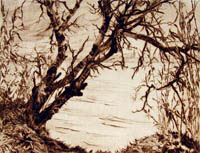
Ebro's river bankIn 1948 he won in competition the "Great Prize of Landscape" by the Fine Arts Academy of Spain in Rome. This scholarship is granted by the Department of External Affairs. It was equivalent in merits to a bachelor's degree in Fine Arts, had Benet not had such studies. It is also equivalent to a National Second Prize. With him there were also pensioned: Andrés Conejo Merino, Victoriano Pardo Galindo and Manuel López Villaseñor, in figure painting; Benjamín Mustieles Navarro and Carmelo Pastor Plá, in sculpture; Fernando Cruz Solís, in die sinking engraving; Luís Alegre Núñez, in engraving and Ramón Vázquez Molezún, in architecture. Don Fernando Labrada was then the director of the Spanish Academy in Rome.

Roma. Via ApiaTo start his grant Benet moved his residency to Rome in 1949. From there and during four years he would visit the museums of many European cities to study the work of the great masters, to draw and to paint. He traveled to France, Great Britain, Belgium, the Netherlands, Austria, Germany, Denmark, Sweden, Norway and Italy which he traversed, drew and painted from north to south.
He continuously participated in many collective and individual art exhibitions. Among them in the XXV International Biennial of Venice, the "Pinacoteca di Brera" in Milan, as well as in those organized at the many foreign academies in Rome.
In 1952 he won the National Third Prize at the exhibition of Fine Arts in Madrid with his oil painting named "Trastevere".
He returned to Spain in 1953 and presented his creations in Barcelona, Madrid, Tortosa and Olot.
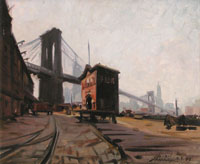
Brooklyn Bridge. New York
In 1954 he started to work at the Art School in Tortosa. He taught art history and drawing.
A year later, in 1955, he obtained by unanimity the first prize of the "Pensión Conde de Cartagena" of the Fine Arts Academy of "San Fernando" in Madrid. It was a two year grant, and the pensioner could choose its destiny among several countries. Benet Espuny chose the one he felt farthest from the European culture where he had received all his training, in order to widen his artistic experience: the United States of America. During his stay there he would paint and visit the art museums of cities as New York, Boston, Chicago, Cleveland, Washington D.C., Saint Louis, Detroit, Philadelphia, New Haven, as well as Toronto, Ottawa, Quebec, Montreal and Halifax in Canada.
Thanks to the support of Dr. Theodore Rousseau, Director of the Modern Art section at the Metropolitan Museum of New York, and Dr. James J. Sweeney, Director of the Guggenheim Museum, he exhibited his work at the Waldorf Astoria of New York in 1956. That same year he had an art show at the Barzansky Gallery of New York as well.
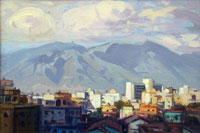
View over Caracas
His scholarship ended on 1957. Instead of returning to Spain, he decided to visit some countries in South America. He visited and drew in Ecuador, Colombia and Venezuela. In this last country he got married, settled down and had a family.
In Venezuela he became chief artist of the Adult Education division in the Department of Education. He collaborated with an important collection of drawings for "El Farol", magazine of the Creole Petroleum Corporation in Venezuela; "Shell" and "Reportajes".
He also taught drawing at the National School of Nursing at the University of Caracas.
Benet Espuny would reside in Caracas until 1971 when he returned with his family to his native Tortosa.

Portal del Palau:
a nook in his home town.He arrived on April, and in September he had enough new material to celebrate an art show at the "Centro del Comercio of Tortosa", during the local city festivities of "La Cinta". From then on and until 1985, he would exhibit there and during those festivities every other year.
In 1972 he presented over 80 art works, among drawings, oil paintings and etchings, at the "Galeria Quixote" in Madrid. The show was a great success, but to the artist it meant both a personal and an artistic achievement after so many years of absence in his country.
The following year he began teaching to draw and etching at the "School-Atelier of Arts and Crafts" in Tortosa. He enjoyed very much the task of being a teacher, as it would allow him as well plenty of free time to paint.

rastevere, work he presented
in his degree dissertation
In 1980 he obtained his masters degree by the Fine Arts Faculty for the "Universidad Complutense" in Madrid. The theme of his dissertation was a small oil painting titled "Trastevere" in which he captured the warmth of the Eternal City.
Later, the 25th of March 1981, he was named by unanimity "Académico Correspondiente in Tortosa" by the "Reial Acadèmia Catalana de Belles Arts de Sant Jordi".
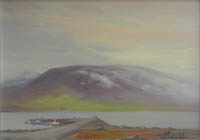
Thingeyri. Islandia
In 1988-89 he and his wife traveled to Reykjavik (Iceland), to visit a daughter; to New Milford (CT, USA) where it lived another one, and to Venezuela. In the town of New Milford, the New Milford Trust for the Historical Preservation and the Town Commission for the Arts organized the exhibition "A Spaniard Sees New Milford". The show took place at the then newly restored New Milford Train Station and it presented oil paintings he did during his three months stay in the town.

New Milford Railway Station
Benet Espuny abandoned his artistic activity in 1993, after his return from a trip to Querétaro in Mexico, due to health problems aggravated by his advanced age.
On 2001 the Hispanic Society of America in New York named him unanimously Honorary Member.

Los Andes
The 14th of June 2002 it was inaugurated a retrospective exhibition of his work at the "Tinglado 1 del Moll de Costa", organized by the Port Authority of Tarragona. A large amount of his work was presented, many of them the property of private owners. It was a showcase for the artist in which one could appreciate the great amount of work Benet Espuny had accomplished during his long artistic life; his great dominium of the drawing, engraving and oil painting techniques; his ability to adapt to different themes, landscapes, and environments; his stylistic evolution as an oil painter and his curiosity and interest for the world in which he has lived.
Benet Espuny has donated eight of his etching plates to the National Chalcography in Madrid.
A collection of etchings had been donated by the artist to the Hispanic Society of America in New York.

Querétaro's domes. Mexico
On January 2004 he also donated a collection of his etchings to the "Reial Acadèmia de Belles Arts de Sant Jordi" in Barcelona. They were received by its president, Dr. Jordi Bonet; Dr. Francesc Bonastre, professor at the "Universitat Autònoma de Barcelona" and Ms. Begoña López, soprano.
Nowadays José Benet Espuny lives in Tortosa surrounded by all his loved ones.
